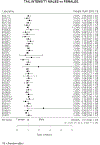The hCOMET project: International database comparison of results with the comet assay in human biomonitoring. Baseline frequency of DNA damage and effect of main confounders
- PMID: 34083035
- PMCID: PMC8525632
- DOI: 10.1016/j.mrrev.2021.108371
The hCOMET project: International database comparison of results with the comet assay in human biomonitoring. Baseline frequency of DNA damage and effect of main confounders
Abstract
The alkaline comet assay, or single cell gel electrophoresis, is one of the most popular methods for assessing DNA damage in human population. One of the open issues concerning this assay is the identification of those factors that can explain the large inter-individual and inter-laboratory variation. International collaborative initiatives such as the hCOMET project - a COST Action launched in 2016 - represent a valuable tool to meet this challenge. The aims of hCOMET were to establish reference values for the level of DNA damage in humans, to investigate the effect of host factors, lifestyle and exposure to genotoxic agents, and to compare different sources of assay variability. A database of 19,320 subjects was generated, pooling data from 105 studies run by 44 laboratories in 26 countries between 1999 and 2019. A mixed random effect log-linear model, in parallel with a classic meta-analysis, was applied to take into account the extensive heterogeneity of data, due to descriptor, specimen and protocol variability. As a result of this analysis interquartile intervals of DNA strand breaks (which includes alkali-labile sites) were reported for tail intensity, tail length, and tail moment (comet assay descriptors). A small variation by age was reported in some datasets, suggesting higher DNA damage in oldest age-classes, while no effect could be shown for sex or smoking habit, although the lack of data on heavy smokers has still to be considered. Finally, highly significant differences in DNA damage were found for most exposures investigated in specific studies. In conclusion, these data, which confirm that DNA damage measured by the comet assay is an excellent biomarker of exposure in several conditions, may contribute to improving the quality of study design and to the standardization of results of the comet assay in human populations.
Trial registration: ClinicalTrials.gov NCT02231736.
Keywords: Biomarkers; Comet assay; DNA damage; Human biomonitoring; Pooled analysis.
Copyright © 2021 The Authors. Published by Elsevier B.V. All rights reserved.
Conflict of interest statement
Declaration of Competing Interest The authors report no declarations of interest.
Figures




References
-
- Collins AR, The comet assay for DNA damage and repair: principles, applications, and limitations, Mol. Biotechnol 26 (2004) 249–261 - PubMed
-
- Azqueta A, Collins AR, The essential comet assay: a comprehensive guide to measuring DNA damage and repair, Arch. Toxicol 87 (2013) 949–968. - PubMed
-
- Møller P, The comet assay: ready for 30 more years, Mutagenesis 33 (2018) 1–7. - PubMed
-
- Neri M, Milazzo D, Ugolini D, Milic M, Campolongo A, Pasqualetti P, Bonassi S, Worldwide interest in the comet assay: a bibliometric study, Mutagenesis 30 (2015) 155–163. - PubMed
-
- Azqueta A, Ladeira C, Giovannelli L, Boutet-Robinet E, Bonassi S, Neri M, Gajskii G, Duthie S, Del Bo C, Riso P, Koppen G, Basaran N, Collins A, Møller P, Application of the comet assay in human biomonitoring:an hCOMET, Mutat. Res 783 (2020) 82–88. - PubMed
Publication types
MeSH terms
Substances
Associated data
Grants and funding
LinkOut - more resources
Full Text Sources
Medical
Research Materials

